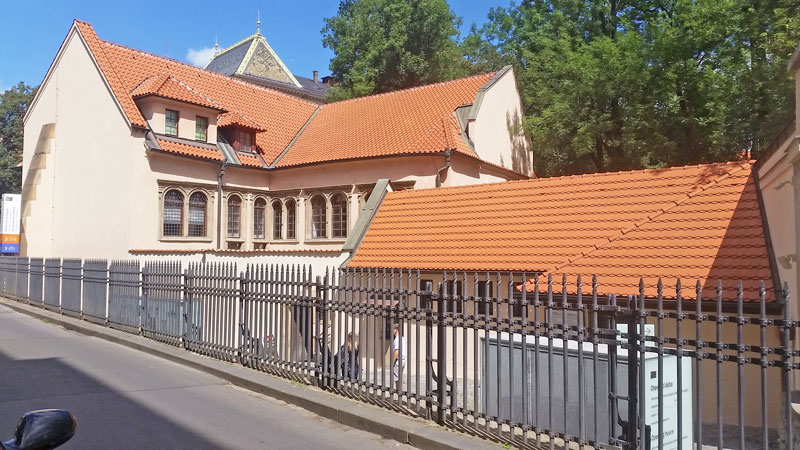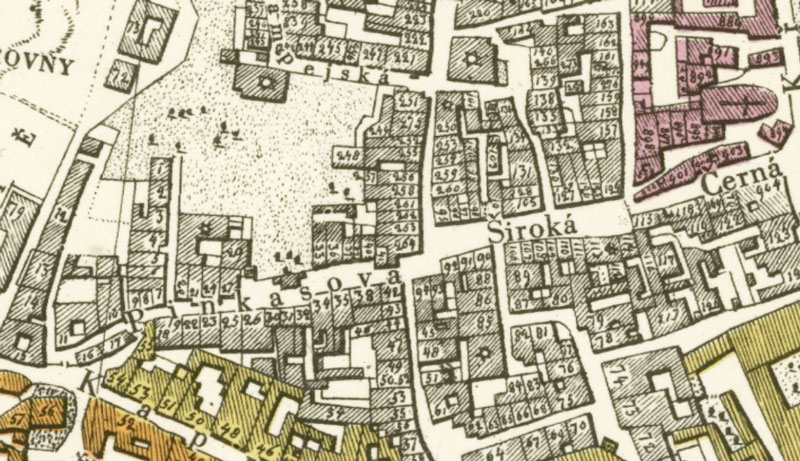Pinkas Synagogue, a National Holocaust Memorial
Sometimes you can look at a building and have an idea of what came before a certain time and what came after. This post about the Pinkas Synagogue can also be broken into two parts. Before and after World War Two. The Pinkas Synagogue is on the route of the Old Town and Jewish Quarter Walking Tour and also take time to read some Skip the Line Tips and Tricks for exploring here.

Origins
Before the Pinkas Synagogue there was a house (or separate buildings which formed a house complex) and it belonged to an important man called Aharon Meshulam Zalman Horowitz. A ritual bathing place (Mikveh) was dated from the late 14th Century so it makes sense as a Rabbi would use a Mikveh before giving a sermon that there must have been a prayer house as well but there is no documented evidence of this until 1492. It’s not long after this that we get the first mention of a new synagogue for the Horowitz family being built in this place by 1535. Aharon Horowitz died in 1545 when Emperor Ferdinand I expelled the Jewish population and he was later buried in the Old Jewish Cemetery.
It was initially a private synagogue so it could have had the name of the family but it was built in what was then called Pinkasova Street and no document that I have ever read has ever referred to this place in any other way than Pinkas Synagogue. Just to note that tourists would normally start their exploration of the Jewish sites by visiting the Pinkas Synagogue and then the attached Old Jewish Cemetery.
The popular picture to take, like the one at the top of the page, is from the Siroka side of the building showing the expanded Pinkas Synagogue and entry but the orientation of the building was never like this.

Look at this street map above from 1816. Look for the big street called “Pinkasova” and above the “i” is a smaller street almost like an alleyway. In this narrow street are buildings numbered 3, 4 and 5. The Pinkas Synagogue is opposite. You can see how the synagogue is almost surrounded on two sides by buildings and on the other two sides by the Old Jewish Cemetery. Hard to imagine but more than 80% of the buildings on this map would be demolished in the next 30 years including every residential house that surrounded the synagogue.

Now let’s skip to 1889. This picture above shows the same geographical area in a city development planning map where the old Pinkasova Street was (black line) and how the street would be redeveloped into what you see today (red line) after the Destruction of the Jewish Ghetto. It might be a bit confusing because the larger part of the street was renamed to Josefovska when the Josefov district was created in 1849 but the little street retained the original name.
Over the previous 300 years the Pinkas Synagogue had been expanded and had twice had it’s basement floor raised to prevent flooding. In the Jewish Ghetto redevelopment the Pinkas Synagogue was one of the few buildings in the area to be saved from destruction so it all looked pretty good until we get to 1938.
The War Years
In October 1938 the Nazis walked into Czechoslovakia. In March 1939 they walked into Prague and it was made clear to Jewish people that they were not welcome. Adolf Eichmann’s property processing scheme saw to it that nothing of any value could be taken out of the country. So until 1941 if Jewish people managed to leave the country they left their possessions with relatives or with what would become the Jewish Central Museum. As by 1942 services were banned, the Pinkas Synagogue was then used as a warehouse.
In September 1943, some 5000 Czech Jews in family groups were transported from Terezin to Auschwitz-Birkenau but unusually on arrival they got privileges like not being split up, not undergoing any selection process and the kids did not have their heads shaved. They stayed in what became known as the “Family Block”. Whether this was some kind of experiment or not is unclear but exactly 6 months later the survivors from that transport in the Family Block were marched to the gas chambers and summarily executed.

The Communist Era
It was in 1950 that the Jewish Council decided that Pinkas Synagogue’s future role was to be the Memorial to the Czech and Moravian Victims of the Shoah (the Holocaust) and the director, a lady called Hana Volavková, is credited with the idea of writing the names on the internal walls.
It took a few years to agree the details but two men called Jirí John and Václav Boštík began to write the names on September 5th 1955 and the 77,297 names took 4 years to complete. The names were arranged according to districts, then in alphabetical order of surnames for a particular family. Residence location names are shown in yellow, surnames and initials are in red, the rest of the names, dates for birth and deportation are in black. Different family groups and districts are separated by a yellow asterisk. Note that on the east wall (the side which faces Jerusalem), the names of the ghettos and concentration camps are written in black on the sides of an empty tabernacle.
The Pinkas Synagogue reopened officially as a memorial site in 1960 and remained open to the public until 1968 when it “closed for repairs”.
Fall of Communism
Twenty two years later after the fall of Communist power the Jewish Council once again got access to the Pinkas Synagogue and what a state it was in. 95% of the names written in the 1950s had been destroyed either by poor conditions, being whitewashed and in some cases destroyed by building work. From 1990 the synagogue was renovated and the names re-written (although two small panels are the original 1950s text). It reopened in 1992. The Pinkas Synagogue is on the route of the Old Town and Jewish Quarter Walking Tour.
And Finally
Earlier I mentioned that a group of 5000 Czech Jews, mostly families were sent to the “Family Block” at Auschwitz and either died or were summarily executed. The date of the executions was the night of March 8th 1944. After World War Two ended the Jewish Council decided that March 8th would be the day to commemorate all the Czech and Moravian victims of the Holocaust with a special service at the Pinkas Synagogue held every year on that date.
Something Related or a Few Minutes Away
Terezin National Suffering Memorial
Destruction of the Jewish Ghetto
Attraction – Spanish Synagogue
Attraction – Old/New Synagogue
Attraction – Old Jewish Cemetery
Attraction – Museum of Decorative Arts
Art and Culture – House of the Suicide Mother
Art and Culture – Darth Vader Statue
Art and Culture – The Book Tunnel
Prague Streets – Jan Palach Square
Prague Streets – Paris Street – Rebuilding the Jewish Quarter
